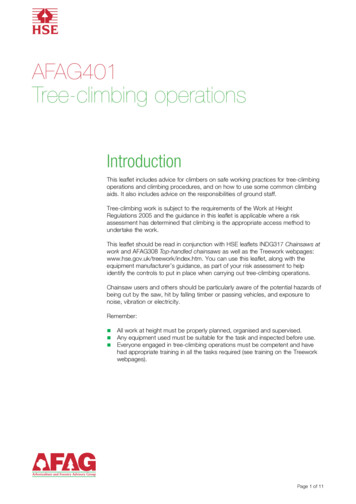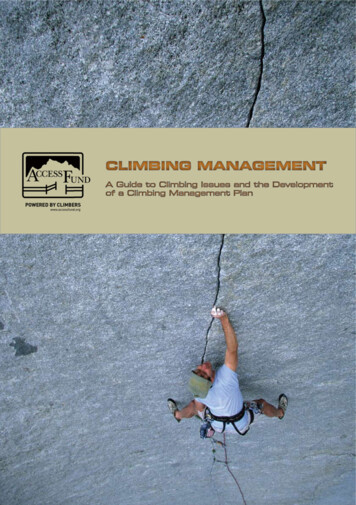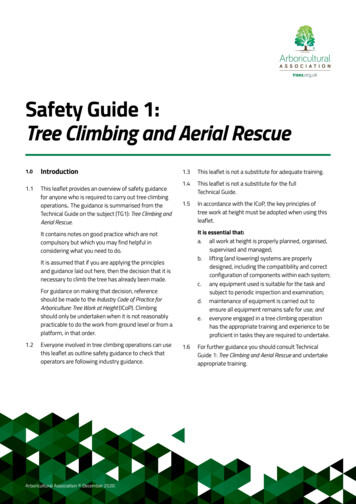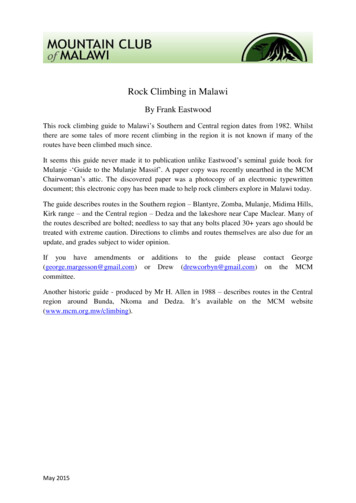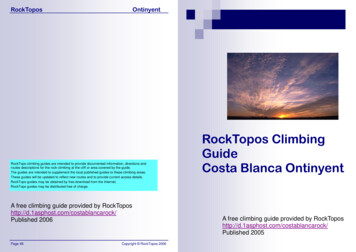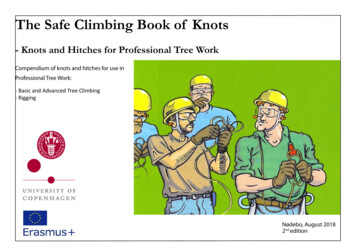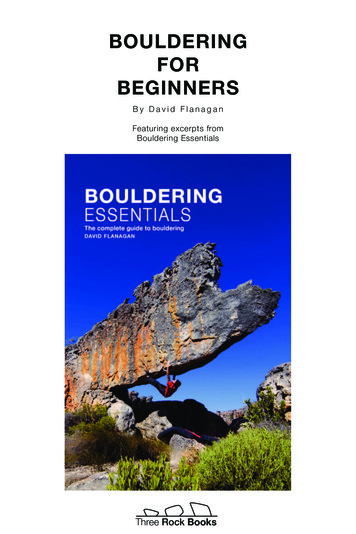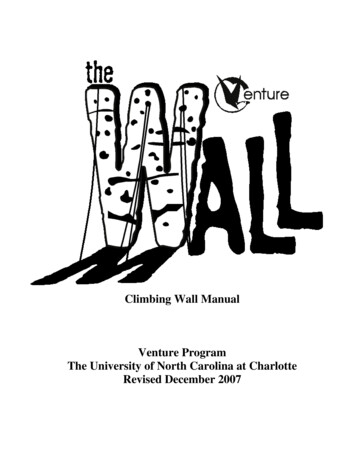
Transcription
ClimbingMerit Badge WorkbookThis workbook can help you but you still need to read the merit badge pamphlet.This Workbook can help you organize your thoughts as you prepare to meet with your merit badge counselor.You still must satisfy your counselor that you can demonstrate each skill and have learned the information.You should use the work space provided for each requirement to keep track of which requirements have been completed,and to make notes for discussing the item with your counselor, not for providing full and complete answers.If a requirement says that you must take an action using words such as "discuss", "show","tell", "explain", "demonstrate", "identify", etc, that is what you must do.Merit Badge Counselors may not require the use of this or any similar workbooks.No one may add or subtract from the official requirements found in Scouts BSA Requirements (Pub. 33216 – SKU 653801).The requirements were last issued or revised in 2017 This workbook was updated in June 2020.Scout’s Name:Unit:Counselor’s Name: Phone No.: Email:http://www.USScouts.Org http://www.MeritBadge.OrgPlease submit errors, omissions, comments or suggestions about this workbook to: Workbooks@USScouts.OrgComments or suggestions for changes to the requirements for the merit badge should be sent to: Merit.Badge@Scouting.Org1. Do the following:a. Explain to your counselor the most likely hazards you may encounter while participating in climbing activities, and whatyou should do to anticipate, help prevent, mitigate, and respond to these hazards.Workbook Copyright 2020 - U.S. Scouting Service Project, Inc. - All Rights ReservedRequirements Copyright, Boy Scouts of America (Used with permission.)This workbook may be reproduced and used locally by Scouts and Scouters for purposes consistent with the programs of the BoyScouts of America (BSA), the World Organization of the Scout Movement (WOSM) or other Scouting and Guiding Organizations.However it may NOT be used or reproduced for electronic redistribution or for commercial or other non-Scouting purposes withoutthe express permission of the U. S. Scouting Service Project, Inc. (USSSP).
ClimbingScout's Name:b. Show that you know first aid for and how to prevent injuries or illnesses that could occur during climbing activities,including heat and cold reactions, dehydration, stopped breathing, sprains, abrasions, fractures, rope burns, blisters,snakebite, and insect bites or stings.Heat and :Abrasions:Fractures:Rope burnsBlisters:Climbing - Merit Badge WorkbookPage. 2 of 8
ClimbingScout's Name:Snakebite:Insect bites orstingsb. Identify the conditions that must exist before performing CPR on a person.2. Learn the Leave No Trace principles and Outdoor Code, and explain what they mean.3. Present yourself properly dressed for belaying, climbing, and rappelling (i.e., appropriate clothing, footwear and a helmet;rappellers can also wear gloves).4. Location. Do the following:a. Explain how the difficulty of climbs is classified, and apply classifications to the rock faces or walls where you willdemonstrate your climbing skills.Class 1Class 2Class 3Climbing - Merit Badge WorkbookPage. 3 of 8
ClimbingScout's Name:Class 4Class 5Classifications:b. Explain the following: top-rope climbing, lead climbing, and bouldering.Top-rope climbing:Lead climbingBouldering:c. Evaluate the safety of a particular climbing area. Consider weather, visibility, the condition of the climbing surface andany environmental hazards.Weather:Visibility:Condition of theclimbing surface:Environmentalhazards:Climbing - Merit Badge WorkbookPage. 4 of 8
ClimbingScout's Name:d. Determine how to summon aid to the climbing area in case of an emergency.5. Verbal signals. Explain the importance of using verbal signals during every climb and rappel, and while bouldering.With the help of the merit badge counselor or another Scout, demonstrate the verbal signals used by each of the following: a.Climbers b.Rappellers c.Belayers d.Boulderers andtheir spotters6. Rope. Do the following:a. Describe the kind of rope acceptable for use in climbing and rappelling.b. Show how to examine a rope for signs of wear or damage.Climbing - Merit Badge WorkbookPage. 5 of 8
ClimbingScout's Name:c. Discuss ways to prevent a rope from being damaged.d. Explain when and how a rope should be retired.e. Properly coil a rope.7. Knots. Demonstrate the ability to tie each of the following knots.Give at least one example of how each knot is used in belaying, climbing or rappelling.KnotUse in BelayingUse in ClimbingUse in Rappellinga. Figure eight on abightb. Figure eightfollow-throughc. Water knotd. Doublefisherman's knot(Grapevine knot)e. Safety Knot8. Harnesses. Correctly put on a commercially made climbing harnessClimbing - Merit Badge WorkbookPage. 6 of 8
ClimbingScout's Name:9. Belaying. Do the following:a. Explain the importance of belaying climbers and rappellers and when it is necessary.b. Belay three different climbers ascending a rock face or climbing wall.ClimbersDateWhat/where 1. 2. 3.c. Belay three different rappellers descending a rock face or climbing wall using a top rope.RapellersDateWhat/where 1. 2. 3.10. Climbing.a. Show the correct way to tie into a belay rope.b. Climb at least three different routes on a rock face or climbing wall, demonstrating good technique and using verbalsignals with a belayer.11. Rappelling.a. Using a carabiner and a rappel device, secure your climbing harness to a rappel rope.b. Tie into a belay rope set up to protect rappellers.c. Rappel down three different rock faces or three rappel routes on a climbing wall. Use verbal signals to communicatewith a belayer, and demonstrate good rappelling technique.Face or RouteDateVerbal Signals 1.Climbing - Merit Badge WorkbookPage. 7 of 8
ClimbingScout's Name: 2. 3.12. Demonstrate ways to store rope, hardware, and other gear used for climbing, rappelling and belaying.When working on merit badges, Scouts and Scouters should be aware of some vital information in the current edition ofthe Guide to Advancement (BSA publication 33088).Important excerpts from that publication can be downloaded meritbadges.pdf.You can download a complete copy of the Guide to Advancement from e Principles of Leave No TraceOutdoor Code1.2.3.4.5.6.7.As an American, I will do my best to—Be clean in my outdoor manners. I will treat the outdoors asa heritage. I will take care of it for myself and others. I willkeep my trash and garbage out of lakes, streams, fields,woods, and roadways.Be careful with fire. I will prevent wildfire. I will build my firesonly when and where they are appropriate. When I havefinished using a fire, I will make sure it is cold out. I will leave aclean fire ring, or remove all evidence of my fire.Be considerate in the outdoors. I will treat public and privateproperty with respect. I will follow the principles of Leave NoTrace for all outdoor activities.Be conservation-minded. I will learn about and practice goodconservation of soil, waters, forests, minerals, grasslands,wildlife, and energy. I will urge others to do the same.Plan Ahead and PrepareTravel and Camp on Durable SurfacesDispose of Waste Properly (Pack It In, Pack It Out)Leave What You FindMinimize Campfire ImpactsRespect WildlifeBe Considerate of Other VisitorsClimbing - Merit Badge WorkbookPage 8 of 8
Climbing Scout's Name: _ Climbing - Merit Badge Workbook Page. 7 of 8 9. Belaying. Do the following: a. Explain the importance of belaying climbers and rappellers and when it is necessary. b. Belay three different climbers ascending a rock face or climbing wall. Climbers Date What/where 1. 2. 3.File Size: 268KB
